The NY Games Conference (NYGC) was held over two days at the end of September at the south tip of Manhattan adjacent to Battery Park in the Museum of Jewish Heritage. An odd-sounding venue, perhaps, but the museum sported a state-of-the-art auditorium that the conference used to host its single-track event. Upstairs from the theater where the lectures were taking place was a large ballroom hosting various exhibitor tables and containing large round tables for people to sit at. Security at the location was beefed up more than usual thanks to the Iranian president staying at the Ritz Carlton across the street, but getting to and from the museum wasn't much of a feat thanks to NYC's subway being a mere two blocks east.
The conference, run by Digital Media Wire (DMW), was very business-oriented and thus was packed with a great many middle-aged men and women wearing suits. DMW reported 300 registered guests, but the theater never seemed to hold more than half that at any given time, although certainly many of the registered attendees weren't interesting in the full conference, as it spanned many areas of the games business, from core to casual to mobile. While the first day only ran from just after noon until five, the second day offered a full 8 hours worth of material. Each morning the conference was opened with a few words from DMW CEO Ned Sherman.
There were a lot of panels; in fact the majority of sessions were panels, but that makes sense when you're trying to condense as much material as possible into two days (really a day and a half) by having as many people as possible participate. The biggest panels brought 6 panelists and a moderator up onto the stage. The thing I hate about panels though is that not only are they hard to cover because you have people tossing things out left and right and keeping track of who says what while you're writing (or typing) and trying to listen to any responses is a pain - but they also are entirely dependent upon the moderator and the direction of the conversations the panel takes. Essentially you have a bunch of people jabber on for 45-60 minutes and hopefully someone says something meaningful every now and then that's applicable outside the direct scope of the current topic under discussion. In other words, relevant to people as a whole.
Still, DMW did take measures to curtail rambling panelists by having a second, slightly smaller projection screen offset from the large center screen where one technician was using an online countdown timer to give each panelist (in some cases) a certain amount of time in which to respond. That second screen was also used to display an online message board called Mozes that posted up anonymous questions or comments people texted in from their cell phones. I thought this was a really cool idea and I was sorely tempted to see if it was being moderated at all by texting something obscene, but I managed to (barely) restrain myself. Several of the conversations in the panels were directed by comments people texted to the big screen. It did have a slightly annoying drawback though of refreshing the whole damn screen every half-minute or so, which on a rather largish projection screen can become quite distracting after a while.
Of the various panels and sessions, the ones that I (personally, mind you) found interesting are covered in the next few pages. The variety of content made this a rather broadly-appealing conference to many business executives. If you're in a position at your company that includes understanding various aspects of the games biz and are looking for insight from other professionals, it's a conference worth attending.
Analysts Panel
A panel of analysts, one each from NPD, CEA and Gfk, were on hand to drown the attending developers with numbers and data sets, which they did with great success with many a pie chart and bar graph and pretty diagram. CEA's analysis from chief economist Shawn DuBravac brought along with it the "recession proof" statement that's been circulating throughout the industry the last few years as the financial world took its slow tumble to where we are today (as in, as of this writing), showing the industry's continued growth in various sectors from mobile to console. They also did a bit of PC game death toting by noting how over 36% of homes have HD with a console hooked up and are bypassing the PC with said console or a set-top box to distribute content, including video games. One of the more interesting factoids they put forth was a study showing that 54% of people who played sports games were more driven to actually watch them on TV, which is a similar correlation to people watching sports on TV and then wanting to actually play them - in real life. Or perhaps they'll just game more instead and create a feedback loop. A survey result showed that the number one feature people wanted in future games was friends list or buddy-linking integration, while being able to download a game came in dead last. It's obviously so high school sweethearts can continue their relationships online through games, as another study shows is happening. Watch out Dad, now you have to stop her from seeing the guy virtually too.
NPD's game business senior manager Michael Klotz of course brought along even more numbers, kicking off with the game industry's 40% growth from 2006 to almost 19 billion dollars in 2007, with a +28% growth predicted for 2008. Of course this is taking into account all facets of the industry, not just software. In an echo from the CEA presentation, a lot more women are becoming involved with gaming, mainly thanks to the Nintendo Wii, which sports a 60% share of women players. Overall though the amount of women and men playing games has almost reached a balance point, and gaming in general has become ever more a part of America's daily lifestyle with 59% of the US population playing games. We're still outranked though by wholesome activities like simply going online (questionable wholesomeness), watching TV (less questionable I suppose) and spending family time (ah, there we go). Michael also pointed out what sites like Kotaku have been mentioning for a while now, in that NPD's numbers only cover retail and not online subscriptions or digital downloads, although they are starting to pull those numbers down as well.
Jen Wu from the Gfk group put up numbers more catered to the mobile side of the market, showing how 21.4% of the US mobile population, or 48.4 million people, play games on their phone each month. Of these, about half (51%) play games only occasionally (which is a point brought up later by Justin Ficarrotta in his iPhone dev talk). The other half plays either almost every day (21%) or at least once a week (29%). The iPhone currently has a 12% lead over smart phones when it comes to gaming, but they are all still a small slice of the mobile gaming pie at only 21% while 50% of gamers use a DS and 28% use a PSP.
The Console vs. PC Debate
This debate session covered was on the following question: which platform is the future entertainment hub and which one is struggling to stay alive? Two teams, pro-console and pro-PC (or con-console) duked it out over the course of 45 minutes. In the beginning, moderator Mike Vorhaus, president of Magid Advisors, asked the teams to close their eyes and took a silent poll of hands from the audience as to who was pro-console and who was con-console. Only about 20-30 people out of about 150 raised their hands against the console. He then gave each panelist three minutes to state their cases.
On the pro-console side sat Justin Townsend, CEO and co-founder of IGA WorldWide, and Robert Stevenson, VP/business development of Atari Group. Robert's argument is that the console is situated in a social environment, the living room, while a PC is usually relegated to a corner or basement. This provides for greater social experiences matching those that players are increasingly enjoying online, while easily hooking up to HD devices and stream in content from Netflix or the Playstation Store, or stream out content to a PSP or DS. Or just outright play media in DVD or Blu-ray. Justin's argument focused more on the failings of the PC to build a full entertainment system, saying how much easier and less expensive it is to build a complete entertainment system with a console rather than a computer
The con-console team consisted of Alex St. John, CEO and founder of Wild Tangent (also one of the original DirectX creators), and John Welch, president and CEO of Playfirst. Alex's argument against the console was very heavy indeed, and was of course delivered in his usual strong and confident manner that tends to make people sit up and listen. Looking back at consoles throughout history, like Atari and Sega, Alex sees the failure of both the PS3 and the Xbox as just another part of the "photonic collapse" (I like that quote) in the console hardware industry. Sony is no longer the company it once was thanks to the enormous losses they've taken on due to the PS3, and Microsoft is still struggling to sell their consoles, slashing prices wherever they can, and their software sales can't even match the number of World of Warcraft subscribers. In fact, due to Sony saying the PS3 is forecasted to last 10 years Alex went so far as to say "there will never be another console. Ever."
Right, taking a break here for some of my own insight. It's a strong statement that Alex proclaimed and that was bounced around several media outlets later that day and the next, but then again there are also stories circulating now about Sony's plans for the Cell processor and the PS4. So is Alex wrong? It depends on how you look at it. Even today, it's hard to define these boxes called PS3 and Xbox "consoles" in the traditional sense. According to Merriam-Webster, a console is still defined as "an electronic system that connects to a display (as a television set) and is used primarily to play video games". Note that last part. While I don't personally use my PS3 often as a video player or music repository, it does support these functions. The Xbox as well can be extended to other forms of media besides games. So, although Sony is developing a PS4, it could be a multimedia box that happens to be able to play games, but also equally services other forms of media and entertainment. It that case, it would be hard to call it a console, and Alex would be correct. In fact, the console may have already died with the Sega Dreamcast, Sony PS2 and Nintendo GameCube.
What about the Wii? Getting back to the debate, Alex stated that Nintendo didn't really make a new console, they created a new device. Nintendo could still come out with an entirely new console, and in fact a high-definition system is making its rounds through the rumor mill at this time, but according to Alex they're still now more of a device company than a console company (Wii Fit, anyone?).
At the end of the debate, several more hands were raised when asked who was con-console, but it wasn't a substantial shift. A Mozes poll was run that let people text in a vote for which team made the better debate, with con-console pulling in all the votes - of which there were only two, but I hadn't even noticed that the poll was running on the second screen. I don't think the debate remained properly focused on the original topic, and kind of degenerated into an economics war at one point, but it still exposed some interesting views into what a console is today, and how it compares now to a PC, which has become a lot cheaper but still too much of a do-anything machine for a lot of people to consider as strictly a multimedia center (excluding, I suppose, those PCs built expressly for such a purpose? That was actually never covered, I don't recall. It was always PCs in the general sense).
iPhone Development Insights
In what was the only development-oriented session of the conference, Justin "Fic" Ficarrotta, game designer and programmer for Brooklyn, NY-based Freeverse, talked about developing games for the iPhone platform. You may also know him from the Best Damn Podcast Ever. He's currently developing two un-announced iPhone titles and brought a wealth of information from his development experiences to share in his talk.
So what's the upshot of developing for the iPhone? Well, perhaps you haven't heard of the cool quarter-million Demiforce raked in from Trism on the App Store. That's right, the simple answer is that the iPhone is still a hot gaming market for anyone who can get in before it starts to cool. Your entry ticket will run you $99 per app, and you take in a rather generous 70% cut on sales through the App Store - Justin of course couldn't give many details of signing your app over due to NDA.
On the software side, Justin said that after downloading the SDK you're up and running in minutes, and it's completely free. He also proclaimed a low learning curve to programming for the iPhone, moreso if you're already familiar with both OpenGL ES and OpenAL. You can also program using Mac-specific APIs but more than likely you'll want to stick with OpenGL ES, which is an OpenGL subset equivalent to OpenGL 1.5, and OpenAL, which is the audio side of the OpenGL system.
There are several design considerations to take into account when developing for the iPhone. First, Justin cautioned that a lot of people play games on their iPhones because they have nothing else to do at the moment. So, waiting in a long line, on the subway, during a boring shift at work - the vast majority do not take out their iPhones just to play games. Remember that it is still a mobile device and focus on the byte-sized gameplay, letting people accomplish things in small sessions. If you try for any full immersion into a game it won't have the same effect as people who dedicate time to a platform, like the PC or Xbox.
Love the accelerometer, but recognize that it has its limits as well. For example, don't think of the iPhone as a Wii controller. It would be nice to have a golfing game where you swing the iPhone like a golf club to hit your shot - but there's the small problem of not being able to really see the screen while you're doing it. Oh and the iPhone has no wrist strap. Imagine breaking a TV and your phone. (though they are pretty damn durable) Still, there are many other cool ways people have put the accelerometers to use, as steering wheels, rolling balls through labyrinths, shaking dice to roll them, and having the orientation of the iPhone determine the force of gravity. The accelerometers track all three axis of movement.
Then there's the multi-touch capability, which can be exploited in just as many ways including pinches, flicks, swipes, drags, taps, gestures and a variable number of fingers tracked simultaneously. Already games are using gestures (The Force Unleashed) and most commonly sliding or dragging (brickout clones). Along with multi-touch comes the issue of controls, and the iPhone has no buttons (none that you can use, anyways). Until iPhone game pads come along, you're stuck with the following d-pad options:
- Mapping them to the accelerometer. Tricky to do without making the game too sensitive but at the same time allowing the player to still see the screen properly
- On-screen buttons. Better, but there's no tactile feedback in the iPhone's screen (yet) and the buttons will ultimately take up screen real estate (like in the NES emulators)
- Virtual joystick. The best option, if you have to take it. Wherever a player places their finger at any time is the center of the controls, and sliding left/right or up/down creates input based on that initial location. It feels more natural and still covers the screen, but not as much as buttons
Publishing, as mentioned before, is done completely through Apple and the App Store. There is a certification process, but nothing nearly as rigorous as, say, Microsoft's XBLA process - which makes developers cry on a regular basis. Justin has been given approval the same day, other times it's taken up to 2 weeks for Apple to push the game through, but on average the turn-around times have been around a week or so. Apple does not allow people to download priced games to try out, so the common practice is for developers to create a "Lite" version that they then sell on the App Store for free.
The Paid/Free options make up the breadth of the App Store, and you can choose one, another or both in which to publish your games (it was never mentioned by Justin whether publishing a free and paid-for version requires you to pay $198). iTunes also gives apps the normal exposure, like music, in terms of What's New, What's Hot and Staff Picks lists.
Since the app market is still fairly fresh, price wars are running rampant. One game, Cro-mag Racing, used to be $10, and since its release it's quickly dropped to $5 and then to $2. Justin says that if there exists a sweet spot, it's very low. As with any free-for-all market, he says, it's important that you provide lasting value and that it gets into the hands and eyes of the players.
One notorious method of getting noticed as a paying app that Justin balefully spoke of was taking advantage of the fact that apps in the Top 25 list hold their place if they switch from paid-for to free or vice-versa. So companies have been releasing their apps for free until they climb to the top of the Top 25 Free Apps list, and then start charging $.99 and wind up at the top of the Top 25 Paid Apps list. Sneaky, sneaky.
Don't forget too that there are other ways to cash in on the App Store, like advergames along the lines of Audi Racing or utilities that service games such as Warcraft Characters or Armory Spy Lite.
Sony Online Entertainment Keynote
Sony Online Entertainment's president John Smedley took the stage to speak about SOE's upcoming free-to-play (FTP) title Free Realms, and how SOE was evolving to match the pace of gamers in the online virtual space. John opened up with a bit of history about himself, how as a kid he would enjoy playing board games around the table with his family, and as he grew into his teens became immersed in Dungeons and Dragons with his friends. This was the experience he had always looked to craft with online games, to bring players and even families together.
Everquest was his showcase example. People play this game 20-30 hours a week, many times at the expense of other things, like their own friends and family. But they make up for it with a rich interaction in an online world, especially now that Sony has deployed Station Voice to a number of its online worlds, including Everquest and Star Wars Galaxies. Already over 70% of users are interacting via voice. He highlighted the numerous conventions for Everquest, most notably Fan Faire, and showed a video of a couple who had met online getting married at a Fan Faire, both in real life and in the game right afterwards.
In detailing Free Realms, John pointed out the fact that today, kids have no concept of a world without online interaction. Even when they're younger they have sites like Webkins or Club Penguin to get them started in virtual worlds, from there they're off and running. To capture the most out of young audiences, Free Realms is targeted both at girls and boys - one of the ways they're doing this is to have combat enabled only by choice by placing them in well-defined locations for players to access if they wish. The majority of the gameplay is spent on mini-games or tasks that are associated with your player class, like making up new recipes if you're a chef. The game also lets you change player classes at any time during the game, so you can be a ninja (no, really - they have ninjas!) for a while, and then become a farmer. You can also own pets, which are each uniquely crafted personality-wise - the dog that John showed us, for example, would express much love for penguins waddling around, but when John went cow-tipping (yea, it was hilarious) the poor pup stood off at a distance shaking with its tail between its legs in fear of the cows. You can also teach them how to do tricks. More expansive than mini-games are events like racing and soccer (the latter to be included about a month after launch in January, with more planned) that people can participate in online. You can join a racing team and keep a car at your house in a garage.
Like all FTP games, monetization comes in the form of subscriptions and an in-game store that lets players add credit through various means that parents can set up for their kids. A $4.99/mo membership will also net players some exclusive content and other goodies not accessible to players participating for free. In order to get people playing quickly, the Flash-based website streams the client to the player so they can access the game and start playing in under one minute.
In closing, John showed off trailers for other upcoming SOE titles The Agency and DC Universe.
Teen Gamers on Gaming
An interesting panel comprised of male and female high-schoolers ages 14-17 and moderated by Jacquie Lane, VP of C&R Research, was given to take a look into the lives of actual teenage gamers. I say "interesting" in reference to the concept, in actuality the takeaway was rather small. The crop of teens didn't seem to have a good range of interests and the moderator didn't really direct discussion towards areas of real relevance. Still, a few tidbits eeked out:
- A majority of the kids voted gaming as one of their top 5 activities, said it was better than just watching TV
- If they didn't have any games to play, they would probably be outside instead
- The Wii was generally accepted as a "cool" console, the Xbox was a bit too core for some of the female gamers
- One girl mentioned how she liked playing co-op with her brother so they could psyche each other up while playing together
- Some said they didn't like playing online because there was no storyline to follow
- A lot said they still like to play their older consoles, like N64
- ne girl said she only joined Facebook because she learned that Pokemon was on it
- A majority of them did not download much in the way of online content, a few were even unaware you could do so (on a Wii)
The Life of a Pro Gamer
Another seemingly off-track session was by pro gamer Kyle "ksharp" Miller, who was interviewed on the stage by Michael Kane, an entertainment features writer from the NY Post. I'll be honest when I say that I really did want to be a pro StarCraft player back when I was in high school - but sneaking a few hours on the computer every few nights just wasn't cutting it for me. Kyle was lucky enough to have parental support, and his mother even drove him to his first tournament in Dallas. He started as a casual Counter-Strike (CS) player when he was between 14 and 15, then joined a team and started playing online once he got wind of competitions.
Kyle was on the scene when competitive gaming was just getting its start, and so he rode the wave once he had become a successful CS player and joined up with a sponsored team. Back then team prizes were only around $5,000, but when you're only in your late teens with little or no expenses, that's a decent chunk of change to pocket. He did various competitions around the world up until the age of 22, when he retired. It was time to seek richer pastures in the workforce.
He only worked government contracts for a year or so before being called back to pro gaming by the Championship Gaming Series (CGS) to be a part of their New York 3D team playing Counter-Strike: Source. Although he got out of gaming because the money no longer matched his lifestyle, the CGS was a new breed of tournaments, and case in point - this year's world finalist team took home 100x the amount of prize money Kyle used to be fighting for. He now practices 3-4 hours a night with his team mates.
Ahhh the good life...
Photo Gallery
For more photos, check out the photo album on the GDNet Facebook page.

The theater at the Museum of Jewish Heritage
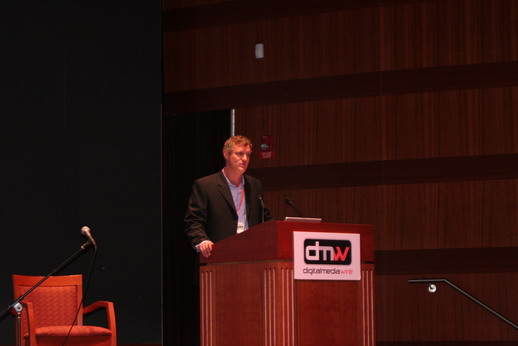
A secondary projection screen showed a web forum that people could text message to from their cell phones for comments and questions - great idea!
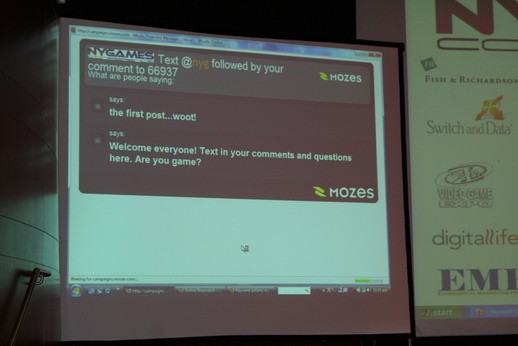
upstairs in the exhibition room, which also doubled as the reception area
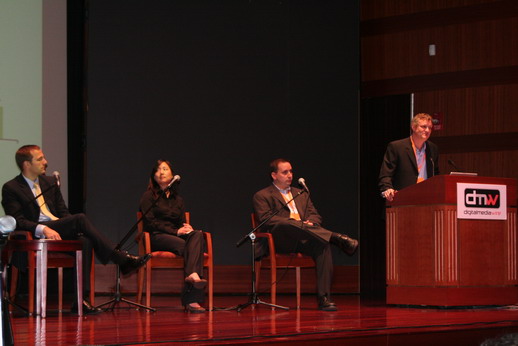
Ned Sherman, CEO & Publisher of Digital Media Wire and producer of the NYGC

The analyst panel, moderated by Ned Sherman. (L to R) panelists: Shawn DuBravac, NPD; Jen Wu, Gfk; Michael Klotz, NPD

The console vs. PC debate, moderated by Mike Vorhaus, Magid Advisors. (L to R) Panelists: Alex St. John, Wild Tangent; John Welch, Playfirst; Justin Townsend, IGA Worldwide; Robert Stevenson, Atari Group
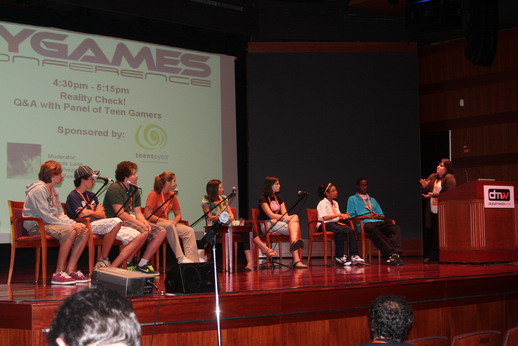
a panel of 14-17 year old gamers answers questions on their gaming habits, moderated by Jacquie Lane, C&R Research
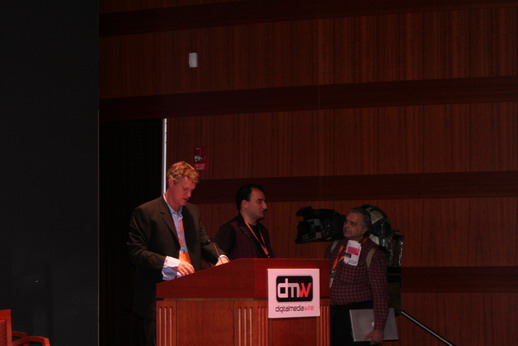
Justin Ficarrotta (center) prepping for his lecture on iPhone game development (yes, that guy to his right *is* wearing a camera over his shoulder)
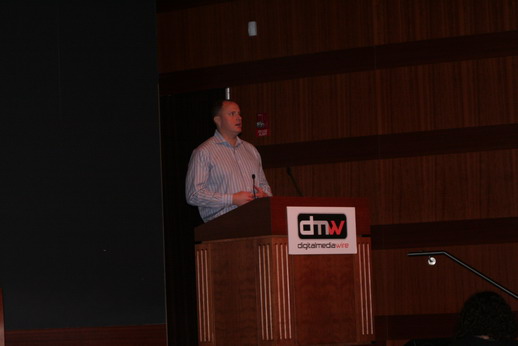
Sony Online Entertainment president John Smedley talks about online community SOE's goals for the online marketplace
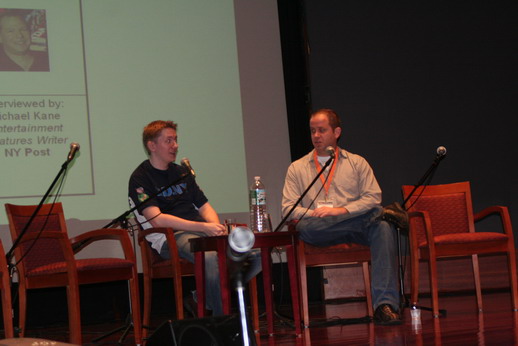
Michael Kane from the NY Post interviews professional gamer Kyle "kSharp" Miller, from the CGS team 3D New York



